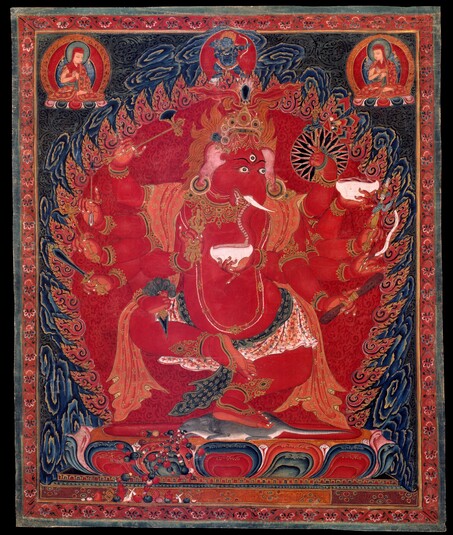
Item: Ganapati (Indian God & Buddhist Deity) - Red (12 hands)
| Origin Location | Tibet |
|---|---|
| Date Range | 1500 - 1599 |
| Lineages | Sakya, Ngor (Sakya) and Buddhist |
| Size | 41.28x33.99cm (16.25x13.38in) |
| Material | Ground Mineral Pigment on Cotton |
| Collection | Rubin Museum of Art |
| Painting School | Ngor |
Classification: Deity
Appearance: Animal-Feature
Gender: Male
Summary: This form of Ganapati is an emanation of Lokeshvara.
Ganapati, Maha Rakta (Tibetan: tsog gi dag po, mar chen. English: The Great Red Lord of Hosts). A Tantric Buddhist form of Ganapati (Ganesha) related to the Chakrasamvara Cycle of Tantras. This form of Ganapati is regarded as an emanation of Avalokiteshvara.
"...beside a lapis lazuli rock mountain is a red lotus with eight petals, in the middle a blue rat expelling various jewels, [above] Shri Ganapati with a body red in colour, having an elephant face with sharp white tusks and possessing three eyes, black hair tied in a topknot with a wishing-gem and a red silk ribbon [all] in a bundle on the crown of the head. With twelve hands, the six right hold an axe, arrow, hook, vajra, sword and spear. The six left [hold] a pestle, bow, katvanga, skullcup filled with blood, skullcup filled with human flesh and a shield together with a spear and banner. The peaceful right and left hands are signified by the vajra and skullcup filled with blood held to the heart. The remaining hands are displayed in a threatening manner. Wearing various silks as a lower garment and adorned with a variety of jewel ornaments, the left foot is extended in a dancing manner, standing in the middle of the bright rays of red flickering light." (Ngorchen Konchog Lhundrup, 1497-1557).
This form of Ganapati belongs to a set of three powerful deities known as the 'mar chen kor sum' or the Three Great Red Deities included in a larger set called 'The Thirteen Golden Dharmas' of Sakya. The other two deities are Kurukulla and Takkiraja.
At the top center is a unique form of the four armed Bhutadamara Vajrapani, blue in colour, wrathful, with a vajra (and trident) and skullcup in the first pair of hands and a drawn bow and arrow in the second pair. This is a non-standard form of the meditational deity Bhutadamara who is typically depicted performing the 'bhutadamara' demon subduing gesture (mudra) with both hands at the level of the heart while also holding a vajra in the upraised right hand and a vajra lasso in the left hand. The Vajrapanjara Tantra and the Bhutadamara Tantra both describe the deity as performing the mudra. The origins of the Bhutadamara associated with Maharakta Ganapati are so far not explained.
Also at the top right and left are two figures wearing monastic attire and red pandita hats typical of the Sakya and Ngor schools of Tibetan Buddhism. The hand attributes for each are a vajra and bell. The figures are unidentified and no inscriptions are found below the figures or on the back of the painting.
Lineage: Vajradhara, Vajra Varahi, Saraha, Nagarjuna, Lord Shavaripa, Hangdu Karpo, Mal Lotsawa, Sachen Kunga Nyingpo, etc. The source text used in the Sakya Tradition was taught by the mahasiddha Krishnacharin and translated by Pandita Gayadhara. It is a little odd that those two do not appear in the official lineage of teachers.
Please see the other companion paintings:
MFA, Boston: Kurukulle.
Museum der Kulturen, Basel: Takkiraja.
Jeff Watt 8-2001 [updated 2-2011]
"The elephant-headed god of wealth, Ganapati, appeared to the siddha, Zangtsa Sonam Gyaltsen, during his meditation and carried him up to the highest peak of worldy existence. Looking out eastward from this vantage-point, Zangtsa saw the kingdoms of Tibet, China and Mongolia stretching out into the distance below him, but the great expanses beyond them so unnerved him that he dared not look further. The deity informed him, "Because you dared not look further, dominion over these lands which you have seen will belong, not to you, but to your descendants. Had you looked further, you would have become the ruler of the universe."
"In order to fulfil his prophecy, Ganapati approached an elderly sage living in solitude at gLang-dor. This great hermit, Se-ston Ripa, was a pillar of the Kahdampa order, a writer of many books and an emanation of the Bodhisattva Avalokiteshvara. The deity requested him to take rebirth in Sakya as the son of Zangtsa Sonam, and Se-ston Ripa agreed."
A Gift of Dharma to Kublai Khan By Chogyal Phagpa, Seventh Patriarch of Sakya. Ngorchen Konchog Lhundup, Ngor chos 'byung, folia 323-328. Translated by Jared Rhoton, 1976).
Publication: Selection of Works - Painting (RMA)
Thematic Sets
Buddhist Deity: Red Wrathful Appearance
Buddhist Deity: Ganapati, Maharakta (Masterworks)
Subject: Power Deities List
Collection of Rubin Museum of Art (RMA): Main Page
Buddhist Deity: Red Wrathful Appearance (Male)
Buddhist Deity: Ganapati Main Page
Subject: Three Great Red Ones of Sakya
Subject: Thirteen Golden Dharmas of Sakya
Buddhist Deity: Ganapati, Maharakta Main Page
Collection of RMA: Ngor Style Paintings
Subject: Caves (Deities & Figures)
Buddhist Deity: Avalokiteshvara (Non-standard Forms)
Collection of RMA: Painting Masterworks Page
Subject: Ngor Masterworks
Buddhist Deity: Ganapati Masterworks



